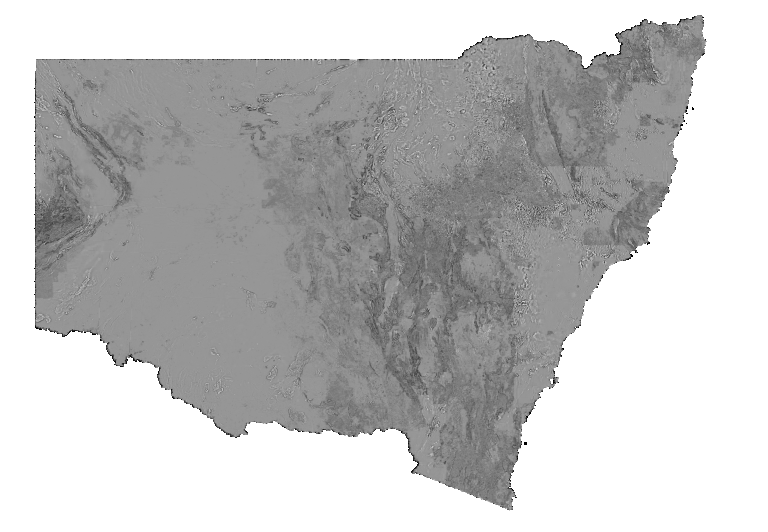NSW Second Vertical Derivative of TMI RTP (2VD TMI RTP)
Greyscale image of second vertical derivative (2VD) of total magnetic intensity reduced to the pole (TMI RTP). Darker tones indicate lower values and lighter tones represent higher values. Reduction to the pole filters magnetic anomalies to appear as if the Earth's magnetic field were locally vertical, as at the magnetic pole (assuming all magnetic sources are inductively magnetised). The 2VD filter shows the vertical rate of change in the first vertical derivative (1VD) of the Earth's total magnetic field and enhances boundaries and structural detail of shallow sources further than 1VD. The 2VD filter enhances magnetic textures in the image, however, it also amplifies non-geological noise. Variations in the magnetic field are caused by lithological factors, principally magnetite (and/or pyrrhotite) content. This Statewide image was generated by merging many individual airborne magnetic surveys.
Simple
Identification info
- Date (Revision)
- 2025-04-16
- Status
- Completed
- Topic category
-
- Geoscientific information
))
- Keywords (Theme)
-
- Geophysics
- Magnetics
- 2nd Derivative
- Keywords (Place)
-
- New South Wales
- Language
- English
Distribution Information
- Distribution format
-
- Web Map Service
Distributor
- OnLine resource
- Download 2VD TMI RTP 2024 ERS file (4.5GB)
- OnLine resource
- Download 2VD TMI RTP 2024 TIF file
Resource lineage
- Statement
- This product represents the 2024 update to the NSW statewide magnetic merge. This version was rebuilt from the line data of all included surveys, and as of the 2020 release, incorporates high resolution open-file company data. MATTHEWS S.J. 2024. New South Wales Statewide magnetic merge, version 3.0 [Digital Dataset]. Geological Survey of New South Wales, Department of Primary Industries and Regional Development, Maitland. MATTHEWS S.J. 2022. New South Wales Statewide magnetic merge, version 2.0 [Digital Dataset]. Geological Survey of New South Wales, Department of Regional NSW, Maitland. MATTHEWS S.J. 2020. New South Wales Statewide magnetic merge, version 1.0 [Digital Dataset]. Geological Survey of New South Wales, Department of Regional NSW, Maitland.
- Hierarchy level
- Dataset
Reference System Information
- Reference system identifier
- EPSG:3857
Reference System Information
- Reference system identifier
- CRS:84
Metadata
- Metadata identifier
- urn:uuid/dcbd5b9f-2bd5-48eb-a897-27c1a8440878
- Language
- English
- Character encoding
- UTF8
Type of resource
- Resource scope
- Dataset
- Metadata linkage
- https://geonetwork.geoscience.nsw.gov.au/geonetwork/srv/api/records/dcbd5b9f-2bd5-48eb-a897-27c1a8440878
- Date info (Revision)
- 2025-04-16T13:26:04
- Date info (Creation)
- 2020-11-19T09:10:59
Metadata standard
- Title
- ISO 19115:2003/19139
- Edition
- 1.0
Overviews

Spatial extent
))
Provided by

 NSW Geoscience Metadata
NSW Geoscience Metadata